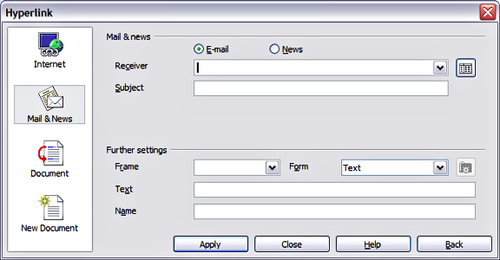Using hyperlinks
When inserting text (such as a website address or URL) that can be used as a hyperlink, Impress formats it automatically, creating the hyperlink and applying to the text a color and underlining. If you do not want Impress to do that, select Edit > Undo Insert from the menu bar or press Control+Z immediately after the formatting has been applied.
You can also insert hyperlinks manually.
To insert a hyperlink, or to customize the appearance of a hyperlink, select Insert > Hyperlinks from the menu bar. The dialog box shown below opens.
On the left hand side, select one of the four types of hyperlinks:
- Internet: a web address, normally starting with http://
- Mail & News: for example an email address.
- Document: the hyperlink points to another document or to another place in the presentation.
- New document: the hyperlink creates a new document.
The top right part of the dialog box changes according to the choice made for the hyperlink type. A full description of all the choices, and their interactions, is beyond the scope of this chapter. Here is a summary of the most common choices used in presentations.
For an Internet type hyperlink, choose the type of hyperlink (choose between Web, FTP or Telnet), and enter the required web address (URL).
For a Mail and News type hyperlink, specify whether it is a mail or news link, the receiver address and for email, also the subject.
For a Document type hyperlink, specify the document path (the Open File button opens a file browser); leave this blank if you want to link to a target in the same presentation. Optionally specify the target in the document (for example a specific slide). Click on the Target icon to open the Navigator where you can select the target, or if you know the name of the target, you can type it into the box.
For a New Document type hyperlink, specify whether to edit the newly created document immediately or just create it (Edit later) and the type of document to create (text, spreadsheet, etc.). For a presentation, Edit now is the more likely choice. The Select path button opens a directory picker.
The Further settings section in the bottom right part of the dialog box is common to all the hyperlink types, although some choices are more relevant to some types of links.
- Set the value of Frame to determine how the hyperlink will open. This applies to documents that open in a Web browser.
- Form specifies if the link is to be presented as text or as a button. See Working with hyperlink buttons for more information.
- Text specifies the text that will be visible to the user.
- Name is applicable to HTML documents. It specifies text that will be added as a NAME attribute in the HTML code behind the hyperlink.
- Event button: this button will be activated to allow OOo to react to events for which the user has written some code (macro). This function is not covered in this book.
Editing text hyperlinks
To edit a text hyperlink, select it (by dragging across the text, not clicking on it), then choose Edit > Hyperlink from the main menu bar. Make changes as needed and click Apply when done. If you need to edit several hyperlinks, you can leave the Hyperlink dialog box open until you have edited all of them. Be sure to click Apply after each one. When you are finished, click Close.
Working with hyperlink buttons
A hyperlink button is inserted in the center of the current slide. In most cases, that is not where you want it to appear. To edit the text or size of a hyperlink button, or to move it to another place on the slide, first display the Form Controls toolbar (View > Toolbars > Form Controls). Select the Design Mode On/Off icon (upper right corner of the toolbar).
Now you can click on the button and drag it to another position, or right-click to open a dialog box where you can change the text on the button, the size of the button, and other properties.
When you have finished editing the button, click the Design Mode On/Off icon again to make the button active again.
| Content on this page is licensed under the Creative Common Attribution 3.0 license (CC-BY). |

